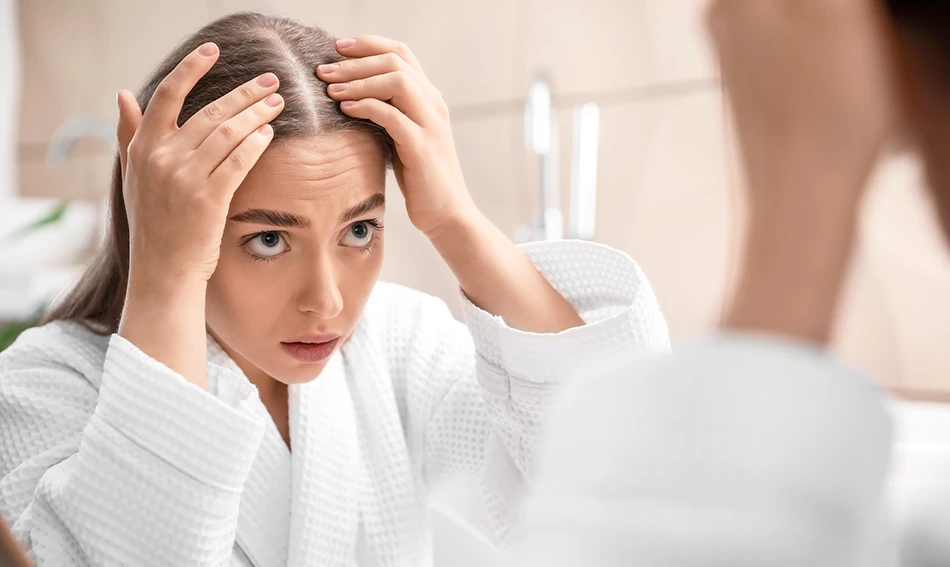Hair Loss: What Causes It and How to Stop It for Good
Are your tresses thinning? Discover how to navigate hair loss and restore a healthy mane in this comprehensive guide.

Hair loss is a common concern affecting men and women across the globe. Whether you’re dealing with a receding hairline, patchy hair loss, or excessive shedding, hair loss can profoundly influence your self-confidence, self-esteem, and general emotional well-being.
This article unravels the intricacies of hair loss, covering the different types, causes, treatment options, and prevention remedies. With this information, you can determine your next steps and empower yourself as you navigate your hair loss journey.
What Is Hair Loss?
Hair loss, medically called alopecia, is when there is a complete or partial loss of hair from areas of the body where it ordinarily grows. Alopecia mainly affects the scalp, but it can occur elsewhere on the body, including the eyebrows, eyelashes, and beard.
Hair loss occurs when something impairs the hair growth cycle. It can be permanent or short-term, depending on the type of hair loss you have. The type also determines the cause and whether it’s diet and medication-led or a manifestation of an underlying medical condition.
Typical signs of alopecia
The type of alopecia determines how it looks. For example, you might witness a sudden loss of hair or gradual thinning in specific places on your scalp. There can be slight differences between alopecia in men and women, too.
The typical signs include:
- Gradual hair thinning: Thinning hair on the scalp that occurs gradually is the most widespread type of hair loss. In men, it’s known as male pattern hair loss or male pattern baldness and typically presents as a receding hairline. In female pattern hair loss or female pattern baldness, women tend to experience overall hair thinning, often beginning with a widening part.
- Bald patches: Hair loss can cause circular bald spots on the scalp or other areas like the eyebrows or eyelashes.
- Excessive hair shedding: You might notice an unusual amount of hair coming out when you brush, comb, or wash your hair. This sudden hair loss tends to cause overall hair thinning.
- Uneven hair growth: Hair that grows unevenly in certain places or patches of noticeably short hair.
- Scaly scalp: Sometimes, scalp redness, scaling, and irritation accompany hair loss.
- Body hair loss: Some forms of alopecia result in hair loss from other areas you’d typically have hair, including the arms, legs, chest, armpits, and pubic region.
What Causes Hair Loss? It Depends on the Type
The reason for hair loss depends on the type of hair loss that you have. A few variables can trigger it, including genetics, hormones, medical conditions, and nutritional deficiencies. Below, you can discover the types of hair loss and their causes.
#1 Androgenic alopecia
Androgenic alopecia, or androgenetic alopecia, is a genetically predetermined disorder that results from an excessive response to androgens – a group of reproductive and growth hormones. It’s a common form of alopecia, affecting up to 50% of males and females.
Androgenic alopecia is slow hair loss that usually occurs in a pattern. In men, it typically begins at the temples, causing a receding hairline. This is known as male pattern baldness. In female pattern hair loss, women tend to lose hair at the crown of the head.
#2 Alopecia areata
Alopecia areata is an autoimmune disease that causes patchy hair loss, with bald spots appearing in places where you’d typically have hair, such as the scalp, beard, and eyebrows. It occurs when the immune system wrongfully attacks the hair follicles where the hair grows.
There is no cure for alopecia areata, and hair loss is often unpredictable. For example, some people can regrow their hair without treatment and never experience hair loss again. Others might cycle through periods of loss and growth.
#3 Anagen effluvium
Anagen effluvium is the loss of hair during the anagen stage of the hair growth cycle. It’s caused by exposure to chemicals that fracture the hair shaft, usually due to medical treatments. It is primarily associated with chemotherapy, a form of cancer treatment. For this reason, anagen effluvium is sometimes known as chemotherapy-induced alopecia.
#4 Telogen effluvium
Telogen effluvium is temporary hair loss caused by hair in the hair cycle’s anagen stage (the growth stage) prematurely entering the telogen phase (the shedding phase). This results in excess shedding, causing hair loss that initially appears as thinning on the scalp.
This type of hair loss is reactive and arises when you experience increased psychological stress, such as surgical trauma or chronic or acute illness. It also commonly occurs as a result of postpartum hormonal changes, with 40–50% of women experiencing postpartum hair loss.
#5 Tinea capitis
Tinea capitis, also known as scalp ringworm, is a fungal infection of the scalp. It is a contagious infection that presents as circular, itchy bald patches on the head. It mostly occurs in children between the ages of 3 and 14.
The dermatophyte species Microsporum and Trichophyton are usually to blame for tinea capitis – these fungi penetrate the hair follicles and invade the hair shaft.
#6 Traction alopecia
The type of hair loss called traction alopecia develops from constant pulling on your hair. When the same hairs are repeatedly tugged, it can lead to bald patches in those areas. Pulling occurs when you wear tight hairstyles, including buns, ponytails, cornrows, dreadlocks, tight braids, hair extensions, and weaves.
How Is Hair Loss Diagnosed?
You need an accurate diagnosis to determine the type of hair loss you have. Dermatologists are experts in hair loss and can identify the reason why you’re losing hair. They can then suggest the best treatment to counter the root cause and encourage new hair growth.
A dermatologist will begin by collecting information and asking questions about your hair loss, including when you began to lose hair, whether it came on suddenly or gradually, and any other symptoms you have. They’ll usually ask about your dietary habits, haircare regimen, medical history, and family history, too, to consider hereditary hair loss.
Your dermatologist will then perform a physical exam, assessing your scalp and other areas where you’re experiencing hair loss. This may include a pull test, where the dermatologist gently tugs on small sections of hair to see how many fall out.
They may administer blood tests if they suspect underlying conditions, such as disease or a nutrient deficiency. You may need a scalp biopsy to diagnose an infection. This involves gathering small skin samples from the scalp and hair follicles and examining them under a microscope.
When should you see a doctor for hair loss?
It’s best to visit your doctor if you are experiencing noticeable hair loss that is causing worry or distress. It’s important to inform your doctor about sudden hair loss because it could be a warning sign for a medical illness, such as a thyroid disorder or severe nutrient deficiency.
While you can’t always cure hair loss, the sooner you seek treatment, the more likely you are to regrow hair and prevent permanent hair loss. For example, male and female pattern baldness usually worsens over time, but early treatment can help you avoid further hair loss.
How to Stop Hair Thinning: Treatment Options for Men and Women
If you want to combat thinning hair, you can seek medical treatment from your doctor. They may prescribe oral or topical medications to treat hair loss. Alternatively, you might prefer a long-term hair loss treatment, such as therapy or surgery, to overcome thinning hair for good.
Let’s look at the treatment options available in more detail.
#1 Oral medications and supplements
Finasteride is a medication prescribed for treating male pattern hair loss by blocking the male hormone dihydrotestosterone (DHT) in the scalp that prevents hair from growing. It works to slow the progression of hair loss, and in some cases, the hair grows back.
You might consider taking supplements for hair growth if you struggle to meet your daily dietary requirements. Nutrafol, for example, contains ingredients like biotin, selenium, and other hair-boosting ingredients, such as collagen, to support your hair and scalp health.
#2 Topical medications
Topical medications are those that you apply directly to the scalp. They target the underlying causes of hair loss and help slow hair loss or boost regrowth. The most popular type is Minoxidil, a non-prescription available in shampoo, liquid, and foam forms that you apply once or twice daily.
#3 Laser therapy
Laser therapy, low-level laser therapy, or red light therapy, is a treatment that involves using low-level lasers to stimulate the hair follicles and encourage new hair to grow. It is considered a safe and non-invasive treatment for hereditary hair loss in men and women.
#4 Microneedling
The microneedling procedure uses a device with tiny needles to create tiny injuries to your scalp. These injuries trigger the body’s healing response. It pumps more blood to the scalp, delivering more nutrients to the hair follicles and restoring collagen to accelerate wound healing.
#5 Hair transplants
Hair transplantation is a surgical procedure that removes hair follicles from one area and relocates them to another. This enables you to restore hair in thinning or balding areas. It’s suitable for people with permanent hair loss, for example, from untreated female pattern baldness.
How Can I Prevent Hair Loss?
Prevention is better than cure, and there are a few ways to decrease your risk of hair loss or prevent further hair loss. These strategies revolve around safeguarding your hair and providing your body with the nutrients it needs to thrive and maintain healthy hair growth.
#1 Follow a wholesome diet
Consuming a healthy diet strengthens your defense against hair loss by ensuring your hair follicles get the vitamins and minerals they need to function and maintain healthy growth. When you’re deficient in certain nutrients, including vitamins A, B, C, D, and E, hair growth slows, and sometimes, hair falls out.
Be careful when following restrictive diets limiting calories and food groups because your hair follicles might miss out on nutrients. For example, some people experience keto hair loss because the low-carb diet bans many fruits, beans, nuts, and vegetables.
Regrowth is possible when you correct deficiencies, but filling your diet with nutrient-dense foods like fruit, vegetables, whole grains, herbs, spices, eggs, and fatty fish is vital. Prioritize these foods over those with sugar and refined carbs, such as breakfast cereals, candy, and white bread, which deprive your body of nutrients and contribute to hair loss.
#2 Dry your hair right
Damaging your hair not only causes breakage and lackluster hair, it can eventually lead to hair thinning and bald spots. And part of this damage occurs when you dry your hair. Wet hair is weaker and more prone to breakage than dry hair, so it’s essential to handle it right.
According to the American Academy of Dermatology, allowing your hair to air dry where possible can mitigate damage. Alternatively, you can gently wrap your hair in a microfiber towel. When you need to blow dry, adjust the heat setting to the lowest available option.
#3 Treat and style your hair with care
How you care for your tresses can affect hair loss and the strength and structure of your hair. Therefore, creating a protective haircare routine is integral to preventing hair loss.
Caring for your hair means avoiding coloring or perming at home, forgoing hot oil treatments, limiting heat tools like curling irons, and avoiding hair products that cause poor scalp health, such as dry shampoo. It also requires basics like using a gentle shampoo and conditioning your hair after washing.
Remember that consistently wearing a hairstyle that pulls on the scalp, such as a tight ponytail, triggers traction alopecia. Mitigate your risk by wearing your hair down, in loose braids, or a loose bun.
FAQs
Several vitamin deficiencies may contribute to hair loss, including vitamins A, B, C, D, and E. Minerals, including iron, zinc, magnesium, and selenium, also have connections with hair loss. Consuming a nutritious diet that balances your vitamin and mineral intake is crucial.
Several health conditions can contribute to hair loss, including alopecia areata, thyroid disorders, systemic lupus erythematosus, syphilis, polycystic ovary syndrome, and severe deficiencies in essential nutrients like iron, zinc, protein, and B vitamins.
Hair loss is very common, affecting more than 50% of women. Female pattern hair loss is the most common type, with approximately 40% of women experiencing hair thinning by the age of 50.
Menopause can trigger hair loss in women due to various hormonal changes. These changes mostly cause significant drops in estrogen and progesterone levels, which can hinder the growth cycle, resulting in gradually thinning hair and altered hair quality.
A Word From a Trichologist
Alopecia can present itself in various ways, from patchy hair loss to complete baldness. How you handle it depends on the type you have.
Many types cause temporary hair loss, such as telogen effluvium, while others can leave you without hair for good. For example, in cicatricial alopecia, or scarring alopecia, inflammation destroys hair follicles entirely.
You can reduce your risk of developing certain forms of hair loss, such as telogen effluvium and traction alopecia, by caring for yourself. For example, eating a nutritious diet to prevent deficiencies, avoiding tight hairstyles, limiting the use of heat tools, and using gentle products.
Talk to a medical professional as soon as possible if you are worried about your hair and scalp health. They can advise you on what to do next to treat and possibly cure alopecia.
Conclusion
Alopecia is a widespread condition that can affect people of all ages and from all walks of life. It can be genetic, medical, hormonal, or the result of a poor diet and lack of hair care. Losing hair can be upsetting, but there are ways to prevent future loss and even restore your hair.
Now you know the symptoms, you can pay close attention to your hair health. If you spot signs of thinning or loss, book an appointment with a board-certified dermatologist. Seeking advice early could be the difference between temporary and permanent hair loss.

















































 Select your language:
Select your language: 








